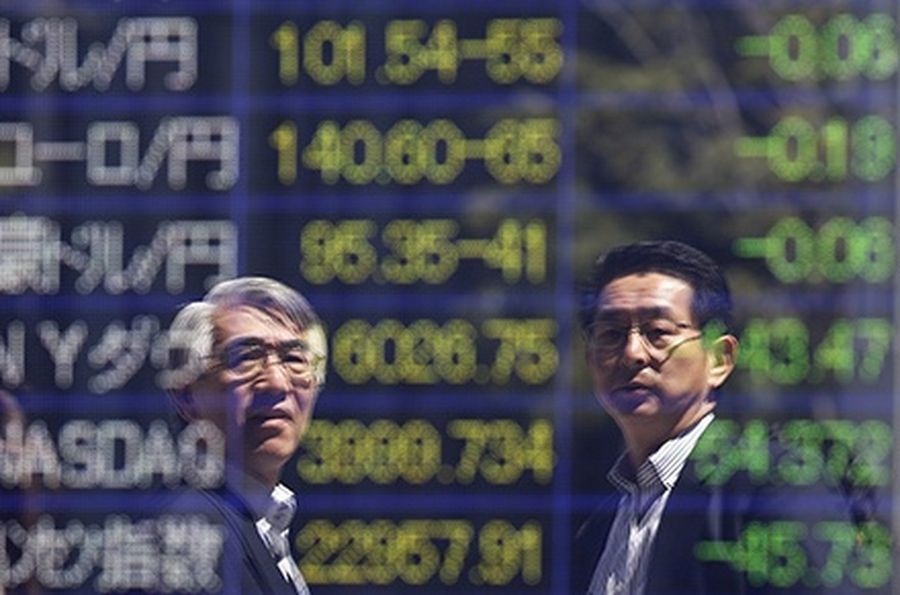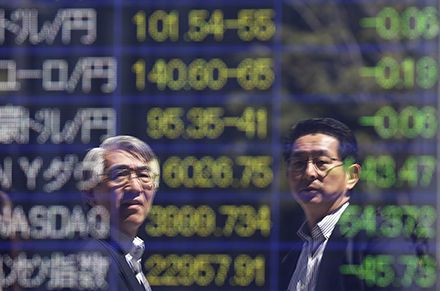The currency freefalls in some of Asia’s emerging economies last year may have been painful, but the drops were contained and did not lead to a dreaded repeat of the 1990s financial crisis. With US rates unlikely to rise soon, the region remains attractive for yield-seeking investors.

Currency comeback
Source: REUTERS/Issei Kato
Tokyo businessmen are reflected in an electronic board showing exchange rates between (from top row to third row) the Japanese yen against the U.S. dollar, the euro, Australian dollar and (fourth row to bottom row) indices of Dow Jones, the NASDAQ and Hang Seng Index, outside a brokerage in Tokyo.
The Asian currencies that suffered the most in last spring’s rout are among the region’s shining stars year to date, evidence that a repeat of the 1997 Asian financial crisis is not at hand and that there may be upside to investing in the region.
A turnaround in the performances of the Indonesian rupiah and the Indian rupee show that investors are willing to recommit funds to Asia’s emerging markets. The reallocation reflects confidence in Asia’s ability to handle the impact of the withdrawal of the US Federal Reserve’s massive monetary stimulus.
The Fed began to unwind its quantitative-easing programme in January. The rupiah has jumped nearly 7% year to date after plummeting 21% to a five-year low on the Fed’s first hint of a scale-back of its bond buying last May. The rupee is up almost 3% after sinking 11% last year on the Fed news.
In fact, most Asia ex-Japan currencies are steady to slightly higher after sliding as much as 8% in 2013. The Fed policy shift was expected to lead to hikes in US rates as early as this December, which would make the US dollar more attractive to investors, who had turned to Asia for higher yields.
The prospect of rising rates has been tempered, however, as the Fed has emphasised rates will stay low for some time, perhaps not rising until the second half of next year.
At the start of the year, few investors were positioned for such resilience in Asia’s EM currencies as the most popular call was for the US economy to lead the global growth story. All the perceived risks were in EM economies in Asia and elsewhere.
The exception to the trend is China, which faces a slowing economy and number of defaults.
The renminbi has dropped about 3% year to date, erasing nearly all of last year’s gain. China’s central bank, however, engineered the slide in a bid to squeeze out speculators, who had been betting on the currency’s continued rise. Many analysts believe the renminbi will regain this year’s losses as Beijing shifts towards a more sustainable consumer-based economy.
A big reason for the comeback in other Asian currencies this year is the prospect of new governments taking control in India and Indonesia this spring and indications of strong economic fundamentals in the region on the back of decisive actions of central banks.
After former Fed Chairman Ben Bernanke first mentioned tapering in May 2013, Bank Indonesia hiked rates a total of 175bp from last June to November and the Reserve Bank of India lifted its policy rate 75bps in the five months to January 2014.
India’s ‘glide path’
India’s current account deficit narrowed sharply to just 0.9% of GDP in the fourth quarter of last year from 1.2% in the preceding quarter and 6.5% a year earlier. The narrowing reflected the effects of a record 10% import tax and other restrictions on gold. Inflation lows also has eased, with consumer price inflation – the now-preferred price indicator – holding near 25-month lows in March of 8.3%.
RBI Governor Raghuram Rajan said in April that the policy rate might not be hiked further near-term if the economy continued on a disinflationary “glide path”.
In Indonesia, after hitting a record high of 4.4% of GDP in the second quarter of last year, its current account deficit narrowed sharply in the fourth quarter to 1.98% of GDP, the smallest gap in a year and a half and better than market expectations. Inflation moderated to 7.3% in March from a high of 8.2% in January. Regulator Bank Indonesia is targeting inflation of 3.5% to 5.5% this year.
A recent BI survey shows there are still lingering upside risks to its inflation target if there are further hikes this year in fuel prices and electricity tariffs. However, ANZ economists Daniel Wilson and Glenn Maguire do not expect further policy rate hikes in the first half of the year.
There would have to be clear stress in the financial markets to trigger any action, Wilson and Maguire said. Also, only three out of 15 analysts in an April 4 Reuters poll expect the regulator to impose a further 25bp–50bp policy rate hike in the third quarter.
Data shows investors are responding positively. Portfolio flows to Asia’s EM have reversed to show net inflows. Unlike in March, when China dominated the change in directional flow, this time there had been a broad-based reversal, ANZ said.
“China is unlikely to compete for this capital in Asia, as it did last year, given the fall in the renminbi and drop in rates. Still, the environment for selling G3 currencies in favour of higher yield EM currencies of all types remains strong.”
The first net inflow in 18 weeks was recorded the week ending April 2, when US$1.2bn moved into equity and bond funds, according to fund tracker EPFR. Another US$1.9bn flowed into funds in the week ending April 9, EPFR said.
Bank of America Merrill Lynch, meanwhile, reported strong demand from all types of clients for Asian EM currencies in an April 7 client note. The strongest flows were into the South Korean Won, the rupiah and the Singapore dollar from hedge funds and into the rupee from real-money clients, Bank of America Merrill Lynch said.
Also, long positions in the rupiah rose in the two weeks before April 10, according to a Reuters poll of 13 analysts. The rise reflected improving fundamentals in Indonesia, although analysts did express some disappointment in the country’s election results, and some believed the currency’s strong run might be nearing an end.
The same survey also showed bullish bets on the Won hit their highest since late November, and that sentiment on the Singapore dollar grew to the most optimistic since late October amid expectations for the central bank to maintain a tight monetary policy.
Malaysian ringgit long positions rose to their largest since May 2013 on demand from funds and interbank speculators, while bullish bets on the rupee were the largest among regional units on stock inflows, the survey said.
Sentiment on the renminbi, meanwhile, was less pessimistic, although short positions remained evident.
Analysts, however, continue to see downside risks in Thailand’s baht because of persistent political instability, poor growth prospects and worries over credit growth, which had been dangerously high until recently.
Looking ahead
Some analysts are not optimistic about the rupee’s prospects. Goldman Sachs believes the currency will continue to benefit from greater portfolio inflows and foreign direct investments, a sharp reduction in the current account deficit and reduced political uncertainty after the elections. Goldman analysts cautioned that more aggressive moves might be capped if the RBI intervened to boost reserves.
Anecdotal evidence suggested RBI had stepped up efforts to rebuild its reserves, Siddharth Mathur, a CitiFX analyst, said in an April 10 report. According to Mathur, there is talk India may roll back its curbs on gold imports, a move that had helped to slash the country’s import bill.
Authorities will move slowly in India, however, Capital Economics analysts said in a report, and so the rupee is likely to remain stable.
Doubt is also creeping in to the rupiah’s prospects. The currency looks expensive, said SLJ Macro Partners. ANZ FX strategists Khoon Goh and HuiYing Chan agreed that much of the positive political and economic news had been priced into the currency.
Goh and Chain said there was also an increasing chance some of the recent strong foreign inflows into Indonesian assets would start to unwind, which would weaken the currency in the near term.
Still, the ANZ strategists expect yield-seeking investors will continue to buy currencies such as the rupiah.
In fact, Richard Yetsenga, ANZ’s head of global market research, said rate drops in peripheral European countries could drive yield-seeking investors to reconsider more attractive, relatively high-yielding EM assets.
China is unlikely to compete for this capital in Asia, as it did last year, given the fall in the renminbi and drop in rates. Still, the environment for selling G3 currencies in favour of higher yield EM currencies of all types remains strong.
Analysts also argue that investors are better off taking their chances in EM generally, since policy responses from EM authorities intent on preventing a crisis are likely to be more rewarding for investors buying those assets rather than shorting them, as the experience of the recent eurozone sovereign debt crisis suggests.
To see the digital version of this report, please click here.
